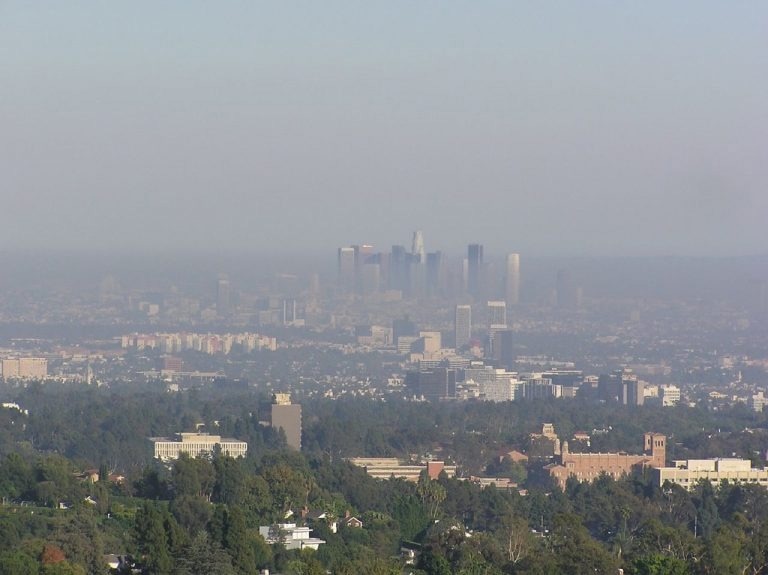The National Oceanic and Atmospheric Administration (NOAA) has awarded a grant to a University of Texas at Austin researcher to investigate how shifting aerosol pollution could impact climate change in the US in the years to come.
 A smoggy day in Los Angeles. Smog consists of aersols that can have wide-ranging impacts on climate change effects. Image Credit: Flickr/Chang’r
A smoggy day in Los Angeles. Smog consists of aersols that can have wide-ranging impacts on climate change effects. Image Credit: Flickr/Chang’r
Aerosols are microscopic solid and liquid droplets released from power plants, automobile exhaust pipes, and industrial and natural sources such as volcanic eruptions. They are responsible for the formation of smog. These tiny particles can alter cloud behavior and reflect or absorb sunlight, which can affect the Earth’s climate.
Geeta Persad, an Assistant Professor at the UT Jackson School of Geosciences, is the lead researcher. Persad and her colleagues will utilize SPEAR, one of NOAA’s premier climate prediction models, to project how alternative aerosol emission scenarios would affect future climatic hazards in the United States, such as floods, fires, and drought, over the next decade.
The study is a part of the broader “Climate Futures: Projections for Socially-Relevant Problems” NOAA initiative. Thirteen research initiatives, which aim to enhance climate change estimates, are part of the program.
According to Persad, aerosols produced by human activity have obscured around half of the global warming caused by greenhouse gas emissions over the course of the industrial age by reflecting sunlight. However, given efforts to significantly reduce air pollution, it is highly unpredictable how aerosol emissions will alter in the future. This has significant effects on how climate change and global warming develop.
In the next 20 to 30 years, [the aerosols] will either stay the same or grow slightly or disappear completely. That is a huge uncertainty in how rapidly climate change is going to accelerate. What we are really trying to do here is ensure that this aerosol uncertainty is going to be characterized appropriately.
Geeta Persad, Assistant Professor, Department of Earth and Planetary Sciences, Jackson School of Geosciences, The University of Texas at Austin
The goal of the research team’s next experiments in the SPEAR model, run by NOAA's Geophysical Fluid Dynamics Laboratory, is to determine how various trends in aerosol emissions affect the continent of the United States' projected climate change between now and 2050. Given the extreme uncertainty around the potential outcomes of global efforts to enhance air quality, the researchers have incorporated a wide range of scenarios.
The Regional Aerosol Model Intercomparison Project, an international project involving similar simulations conducted by various institutions worldwide, will include the new SPEAR trials. Persad and associates will check that various aerosol scenarios—and their impact on the climate—are accurately depicted by comparing the findings of the SPEAR model with those from the other participating models.
A $460,397 grant from NOAA's Climate Program Office's Modeling, Analysis, Predictions, and Projections (MAPP) program supports the project. Using the simulations, Persad and her team will look into how various aerosol scenarios affect heatwaves, intense precipitation, and fire weather throughout the United States. David Paynter, a member of the project team and collaborator with Persad, will use powerful computers at NOAA to run the simulations.
Persad added, “I am grateful to have NOAA’s partnership to help fill this critical knowledge gap in how US climate risk will evolve.”
Persad expressed her hope that the new understanding provided by the SPEAR models will assist in changing climate policy and planning to account for the dangers associated with changing aerosol emissions.
According to Dan Barrie, MAPP’s program manager, this initiative is critical in identifying and planning for future climate hazards.
Dr Persad’s work is critical in evaluating our confidence in projections of climate decades into the future, as aerosols are a significant but often under-evaluated aspect of regional trends in the climate. We are also excited that this project deepens Dr Persad’s relationship with NOAA, where she previously worked at our Geophysical Fluid Dynamics Laboratory.
Dan Barrie, Program Manager, Modeling, Analysis, Predictions, and Projections